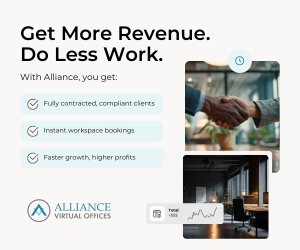- Climate change poses significant risks to office operations, including rising energy costs and extreme weather events.
- Implementing energy-efficient technologies, disaster preparedness, and sustainable materials can help mitigate these risks.
- Proactively addressing climate risks can offer long-term benefits like attracting eco-conscious talent, reducing costs, and enhancing business resilience.
The planet just had its hottest January on record, according to Axios. From raging wildfires in California to days of earthquakes in Santorini, extreme weather catastrophes are increasingly common, and costly.
As climate change accelerates, businesses are confronting environmental, supply chain and insurance challenges that can impact their operations, finances, and long-term sustainability; the risks to the future of work are undeniable.
In the office environment, these risks not only threaten daily operations but can also affect employee well-being, business continuity, and reputation.
Here are some practical, actionable strategies that businesses can implement to mitigate climate-related risks, while also exploring how taking proactive steps can benefit your organization in the long run.
1. Invest in Energy-Efficient Technologies
Energy consumption is one of the most significant sources of climate-related risk for businesses. As energy prices rise and sustainability regulations change, inefficient energy use becomes both an environmental and financial liability.
Offices that rely on outdated infrastructure or inefficient systems are more vulnerable to these growing costs.
What to do:
- Upgrade HVAC Systems: Heating, ventilation, and air conditioning (HVAC) systems are often among the largest energy consumers in an office building. Opt for energy-efficient, smart HVAC systems that adjust based on occupancy and weather conditions.
- Install Energy-Efficient Lighting: Transition to LED lighting, which uses significantly less power and lasts longer than traditional bulbs. Implement motion sensors or automated dimming systems to reduce energy use when spaces are not in use.
- Adopt Smart Building Technologies: Modern smart technologies, such as energy monitoring systems, can track energy consumption in real-time and offer insights into areas for improvement. These technologies can identify inefficiencies and automate systems to reduce energy use during peak hours.
- Renewable Energy Sources: Consider investing in solar panels, wind energy, or procuring renewable energy from local providers. Solar installations, for example, can reduce dependence on the grid and decrease energy bills over time.
By implementing these energy-efficient technologies, businesses can reduce operating costs, minimize their carbon footprint, and build resilience against fluctuating energy prices.
2. Develop a Disaster Preparedness and Response Plan
Extreme weather events are expected to increase in frequency and severity due to climate change, from heatwaves to floods to hurricanes. These disruptions can severely impact your office’s operations, especially if your facilities are not prepared.
The U.S. Federal Emergency Management Agency (FEMA) states that approximately 40% of small businesses do not reopen after a disaster, according to On Point Wealth Partners.
Having a comprehensive disaster preparedness plan in place is essential for ensuring business continuity during these unpredictable events.
What to do:
- Risk Assessment: Start by assessing the specific risks your office faces. If your building is in an area prone to flooding, identify potential weaknesses in the building’s infrastructure. If you’re located in a region with extreme temperatures, ensure that your HVAC systems are capable of keeping employees comfortable and operational.
- Create an Emergency Response Plan: Outline clear steps for employees to follow in the event of extreme weather or environmental hazards. This plan should include evacuation procedures, emergency contact information, and designated safe zones within the office.
- Backup Power Systems: Invest in backup generators or uninterruptible power supplies (UPS) to keep essential operations running in the event of power outages caused by storms, heatwaves, or other disruptions.
- Insurance Coverage: Ensure that your insurance policy covers potential climate-related damage, such as flooding, wind, or fire damage. As the risk of these events grows, insurers may require more detailed assessments of your facilities’ resilience to climate threats.
Having a disaster plan ensures that your office remains operational when disaster strikes, reducing downtime and loss of productivity.
3. Utilize Sustainable Building Materials
The construction and renovation of office buildings can have a significant environmental impact.
From carbon-intensive materials to inefficient designs, many older buildings may be poorly equipped to withstand the effects of climate change.
Updating or retrofitting your office with sustainable materials is an effective way to reduce both your environmental footprint and long-term costs.
What to do:
- Green Building Certifications: Pursue certifications such as LEED (Leadership in Energy and Environmental Design) or BREEAM, which set standards for sustainable building practices. These certifications not only demonstrate your commitment to sustainability but also help guide the selection of energy-efficient systems, renewable materials, and waste-reduction strategies.
- Energy-Efficient Insulation: Install high-performance insulation in walls, windows, and roofing to reduce heating and cooling needs. This will minimize energy consumption and reduce the load on HVAC systems.
- Water-Efficient Fixtures: Install low-flow plumbing fixtures, automatic faucets, and water-efficient irrigation systems to conserve water and reduce utility costs.
- Use of Recycled and Low-Carbon Materials: In office renovation projects, opt for recycled materials, low-carbon cement, and sustainably sourced wood. This reduces environmental impact while contributing to a circular economy.
Investing in sustainable building materials not only alleviates climate risks but can also enhance the long-term durability and energy performance of your office.
4. Embrace Remote Work and Flexible Office Solutions
While physical office spaces remain important, the ability to reduce office footprint and embrace hybrid work models can have significant benefits in reducing climate risk.
By limiting the need for a large physical space, businesses can lower their overall energy consumption and decrease their reliance on office infrastructure.
What to do:
- Remote Work Infrastructure: Set up systems that allow employees to work remotely as needed. When conditions are dangerous, it’s both reckless and shortsighted to still require staff to commute. Invest in secure, cloud-based platforms and communication tools that facilitate virtual meetings, collaboration, and project management.
- Coworking and Shared Office Space: For teams that still need a physical presence, consider utilizing coworking or flexible office spaces. These options provide shared, energy-efficient environments where companies can reduce their overhead costs and environmental impact.
By adopting remote and hybrid work strategies, businesses can dramatically reduce their carbon footprint while offering employees flexibility.
5. Attract Eco-Conscious Talent and Clients
As sustainability becomes a priority for consumers, employees, and investors, businesses that proactively engage with climate-related issues can gain a competitive advantage.
By demonstrating your commitment to the environment, your company can attract top talent, appeal to eco-conscious clients, and enhance its market position.
What to do:
- Promote Green Initiatives: Highlight your company’s efforts to reduce its carbon footprint, from energy-efficient technologies to sustainable office practices. This can enhance your brand’s appeal to clients and employees who prioritize sustainability.
- Communicate Sustainability Goals: Transparently share your goals for environmental sustainability with clients and prospects. A growing number of consumers are making purchasing decisions based on a company’s environmental impact, and top talent is increasingly seeking employers with strong sustainability values.
As climate change continues to alter the global business environment, the risks to office operations are mounting. But by taking proactive steps — such as investing in energy-efficient technologies, preparing for extreme weather events, using sustainable materials, and embracing remote work — businesses can significantly reduce these risks.
Moreover, addressing climate change head-on can offer long-term benefits, such as attracting eco-conscious talent, reducing costs, and building resilience against future disruptions.
In 2025, businesses that proactively address climate risks will be better positioned to thrive in a world where tackling environmental concerns is no longer a choice, but a necessity.


 Dr. Gleb Tsipursky – The Office Whisperer
Dr. Gleb Tsipursky – The Office Whisperer Nirit Cohen – WorkFutures
Nirit Cohen – WorkFutures Angela Howard – Culture Expert
Angela Howard – Culture Expert Drew Jones – Design & Innovation
Drew Jones – Design & Innovation Jonathan Price – CRE & Flex Expert
Jonathan Price – CRE & Flex Expert













